|
|
|
Sort Order |
|
|
|
Items / Page
|
|
|
|
|
|
|
| Srl | Item |
| 1 |
ID:
124664
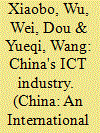

|
|
|
|
|
| Publication |
2013.
|
| Summary/Abstract |
This article provides a review of China's information and communications industry by studying the following three segments: the integrated circuit and related electronic components, equipment and network systems and devices and applications for end users. A review of successful cases sheds light on the trends, challenges and policy implications. The four policies proposed by the authors are: promote local firms to be global technology leaders by constructing new standards in new paradigms, extend the edge enjoyed by the communications equipment segment to the integrated circuit and related components and devices segment via promoting the Internet of Things based on sensor network, encourage local governments to participate in the commercialisation of emerging technologies by establishing regional industry parks/bases and deregulate end users' devices and internet applications to encourage various actors to participate in innovation.
|
|
|
|
|
|
|
|
|
|
|
|
|
|
|
|
| 2 |
ID:
124666
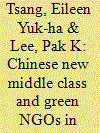

|
|
|
|
|
| Publication |
2013.
|
| Summary/Abstract |
By examining the emerging Chinese new middle class as well as green non-governmental organisations (NGOs), this study finds that while the emergence of the Chinese new middle class facilitates the growth of green NGOs, the Chinese new class are not activists or agitators working against the government. Based on in-depth interviews with leaders of green NGOs in Guangdong Province, this research examines why green NGOs founded by the Chinese new middle class do not call for or advocate environmental protection. It concludes that contrary to conventional wisdom, the Chinese new middle class is a vanguard of guanxi (connections)-seeking, but a laggard in promoting environmental protection and civil-society activism. Green NGOs are principally used as a tool to cultivate social capital in the form of guanxi in order to promote personal material interests.
|
|
|
|
|
|
|
|
|
|
|
|
|
|
|
|
| 3 |
ID:
124665
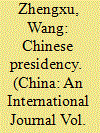

|
|
|
|
|
| Publication |
2013.
|
| Summary/Abstract |
The role of the Chinese presidency includes several important powers such as serving as the paramount leader of the Party, controlling the military, foreign affairs and national security portfolios of state power. With these configurations, a Chinese presidency has taken a preliminary shape - today China can be characterised as a one-Party presidential system. But ambiguities loom extraordinarily large, as the defining lines between Party powers and state powers are still undrawn and the constitutional bases of the presidency are almost entirely missing. Future developments, however, may offer breakthroughs in these areas.
|
|
|
|
|
|
|
|
|
|
|
|
|
|
|
|
| 4 |
ID:
124663
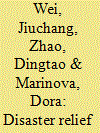

|
|
|
|
|
| Publication |
2013.
|
| Summary/Abstract |
The United States and China, as the largest developed country and the largest developing country in the world, respectively, have their own overt and covert influences on the world. This article discusses the foreign responses when the US was hit by the catastrophic Hurricane Katrina in 2005 and China by the Wenchuan earthquake in 2008. By using a three-stage process to describe disaster aid decisions, it was found that developed countries were more likely to grant disaster aid, but the scale of their assistance was not the largest. Evidence showed that countries were more likely to offer assistance if they were geographically located closer to the affected areas but this was not the case in decisions made on the type and amount of aid provided. Assistance from European countries, on the other hand, largely showed a form of cosmopolitan humanitarianism
|
|
|
|
|
|
|
|
|
|
|
|
|
|
|
|
| 5 |
ID:
124656
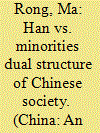

|
|
|
|
|
| Publication |
2013.
|
| Summary/Abstract |
While the "rural vs urban dual structure" has been a key issue for decades since China's social reform in the 1980s, the "Han vs minorities dual structure" receives scant attention in contemporary China. In the latter, Chinese citizens are differentiated by aspects of ethnic identity, administrative units, academic disciplines, education and even in arenas like entertainment and sports. A series of preferential policies targeted at ethnic minorities has been implemented by the government, e.g., family planning, school enrolment, financial assistance, personnel promotion and even the judicature. This dual structure, based on Stalin's theory and the Soviet system, emerged after China launched the "nationality/ethnic recognition" campaign in the 1950s. Many studies have proven that this system strengthened the "nationality" consciousness of each ethnic group but may otherwise be detrimental to national unity. This article offers a historical overview of China's transition from a traditional "central kingdom of the earth" into a modern nation-state, and detailed discussions about the Communist Party of China's new ideological framework on the "nationality/ethnic question", as well as the role that the "Han vs minorities dual structure" plays in contemporary China.
|
|
|
|
|
|
|
|
|
|
|
|
|
|
|
|
| 6 |
ID:
124662


|
|
|
|
|
| Publication |
2013.
|
| Summary/Abstract |
This article reviews the reconstruction of Puning Temple from the 1980s, including repair of the buildings, recovery and managing of the temple's property, re-establishing of sangha, as well as its involvement in tourism and its relations with adjacent villages, based on research done on the basis of files and other materials from Chengde Municipal Bureau of Archives. With reference to a piece of writing titled "Chengde Today" by James Hevia, this article highlights that modernisation, the development of ethnic relations and the perspectives of the state were insufficient to explain the motivations behind the reconstruction of Puning Temple. Divergent interpretations arose due to different perspectives from governmental agencies. Analysis of the various viewpoints provides a clearer understanding of the role of Puning Temple after its reconstruction.
|
|
|
|
|
|
|
|
|
|
|
|
|
|
|
|
| 7 |
ID:
124655
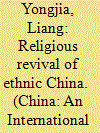

|
|
|
|
|
| Publication |
2013.
|
| Summary/Abstract |
Over the past three decades, Chinese "ethnic areas" (minzu diqu) have experienced widespread religious revival. Religious populations are steadily increasing as the religious infrastructure expands under governmental or non-governmental sponsorship. The restoration of sacred sites appeals to the larger ethnic populations for reasons relating to community and identity (re-)creation. The officially recognised religions are reviving different regimes of transcendence in the ethnically diversified localities. Unofficial, transnational, or radical movements and denominations are engaging in activities either in the sphere of underground proselytising or non-governmental organisation (NGO) instruments. Popular religions are being legitimised through ethnic renaissance and are being embraced by astonishingly large populations. They are also being commercialised by local state agents who are given incentives to generate revenue by translating invented traditions into tourist attractions. Ancestor veneration and the Daoist rituals of consulting almanacs, geomancy, horoscopes and spirit mediums are seasoned with ethnic flavour. However, growing social, political and economic disparities are engendering greater anxiety among people who are seeking answers through the old ways such as oracle reading, mask dances, sutra chanting or karma fairs. The flow of capital, symbols, ideas and practices nationally and globally also poses unprecedented problems of religious pluralism in these increasingly mobile multi-ethnic areas.
|
|
|
|
|
|
|
|
|
|
|
|
|
|
|
|
| 8 |
ID:
124659


|
|
|
|
|
| Publication |
2013.
|
| Summary/Abstract |
Global processes and encounters with modernity have led to unique development patterns in ethnic minority areas in China. Rubber tree planting and rubber production, for example, have forged a link between tropical jungle villages like Mandi in Xishuangbanna (Yunnan Province) and China's booming car industry, and even the wider capitalist world system. As a result, the Dailue ethnic minorities in Mandi have experienced a social change from mechanical solidarity in rice agriculture to organic solidarity in market economic conditions. Such changes also expose Dailue society to increasing "modern" social risks, and this, in turn, has influenced religious practices. The traditional guardian spirit cults of the house (dubula hen), village (dubula ban) and region (dubula moeng) are held responsible for social risk management in Dailue culture. The increasing social risks have compelled people like the Dailue from Mandi to question and revisit the predicament of their folk religion, revealing the ongoing importance of spirit cults.
|
|
|
|
|
|
|
|
|
|
|
|
|
|
|
|
| 9 |
ID:
124660
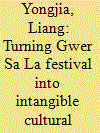

|
|
|
|
|
| Publication |
2013.
|
| Summary/Abstract |
The Gwer Sa La Festival of the Bai in southwest China was recently announced as a national Intangible Cultural Heritage Project and nominated for the United Nations Educational, Scientific and Cultural Organisation world ICH candidacy, largely due to the local government's promotion of Gwer Sa La's religiosity by constructing and materialising the rhetoric of survival by a primitive fertility cult and ethnic carnival. However, the key concern of the participants is Gwer Sa La's potency of prosperity, related to a series of encompassing powers vested in the patron god temples, taken care of by women congregations who renew the power of prosperity during the Festival. It is argued here that the state's efforts to turn Gwer Sa La into an ICH project is an attempt of "superscription without encompassment". The efforts are based on an imagined, primitive fertility cult that leads to sexual promiscuity and which entirely overlooks the locals' concerns.
|
|
|
|
|
|
|
|
|
|
|
|
|
|
|
|
| 10 |
ID:
124667


|
|
|
|
|
| Publication |
2013.
|
| Summary/Abstract |
A symptom common to many industries in China is the proliferation of enterprises. Through a detailed case study based on original data of the automobile industry, it was found that dynamic entry and exit have been taking place. This industry's peculiar environment, in which even critical inputs such as engines and designs can be outsourced, is an important factor that induces rampant entry. Although there is significant economy of scale in the industry, many new entrants have succeeded in making profits by rapidly expanding their scale. Thus, it is incorrect to regard their entry behaviour as irrational. However, the Chinese government has contended that the current structure of its automobile industry is imbalanced and has tried unsuccessfully to consolidate it by encouraging the formation of industrial groups.
|
|
|
|
|
|
|
|
|
|
|
|
|
|
|
|
| 11 |
ID:
124658


|
|
|
|
|
| Publication |
2013.
|
| Summary/Abstract |
The ritualisation of Chinggis Khan worship is indexical to the vicissitudes of nationality (minzu) relationship in China and beyond in the process of nation-building. This analysis helps unveil China's nationalistic dilemma for which different semiotic ideologies and their relevant practices are responsible.
|
|
|
|
|
|
|
|
|
|
|
|
|
|
|
|
|
|
|
|
|